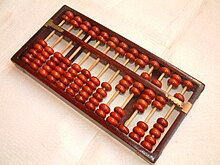By Tech Powered Dad | January 6, 2012
I’ve been thinking about the technologies that pushed the way we use and learn mathematics forward the most over the history of man. Here are my picks for the top 10 in the order they were invented. I’m not a historian, so take it for what it’s worth, and I’ll warn you that I almost entirely relied on Wikipedia for historical information. In other words, this is not a research paper. Consider yourself warned!
Abacus
Invented Approximately: 2700 BC in Sumeria

https://en.wikipedia.org/wiki/Abacus
Arabic Numerals
Invented Approximately: 300 BC
Don’t know what Arabic numerals are? Developed by Indian mathematicians, they are the 10 digits 0-9 that we all use every day. Thank your lucky stars that they won out over some of the alternatives that were out there. Imagine if we were all trying to do long division using the Roman numeral system. Ugh.
https://en.wikipedia.org/wiki/Arabic_numerals
Compass
Invented: 1567
Used for drafting and geometry constructions, the drawing compass had applications for both engineers and students alike. And while it’s more or less been replaced by CAD software for engineers and dynamic geometry software for students, I still feel like there’s something to understanding how a different shapes can be constructed using nothing but your hands a compass and a straightedge.
https://en.wikipedia.org/wiki/Compass_(drafting)
Slide Rule
Invented Approximately: 1620
 If I asked you what the Sin(36) was, I bet you’d just pull out a calculator or computer to find the answer. Before that was possible, your best bet would have been a slide rule, a sort of mechanical calculator. By moving the parts of the ruler (like lining up the Sine column with 36), you could get quick calculations for arithmetic, logarithms, or trigonometry problems. They remained hugely popular right up until the handheld calculator made them obsolete.
If I asked you what the Sin(36) was, I bet you’d just pull out a calculator or computer to find the answer. Before that was possible, your best bet would have been a slide rule, a sort of mechanical calculator. By moving the parts of the ruler (like lining up the Sine column with 36), you could get quick calculations for arithmetic, logarithms, or trigonometry problems. They remained hugely popular right up until the handheld calculator made them obsolete.
https://en.wikipedia.org/wiki/Slide_rule
Pencil with eraser
Invented: 1858
“Everyone makes mistakes, that’s why pencil’s have erasers,” goes the popular saying. But until 1858, pencils didn’t have erasers, when Hymen Lipman added it to the writing device that had been around since ancient times. The eraser was the perfect addition for math students, who now had the ability to quickly and neatly correct mistakes made in working their problems. Today, many math teachers will only accept homework completed with a pencil
https://en.wikipedia.org/wiki/Pencil
Turing Machine
Invented: 1936
 The Turing Machine isn’t really a machine at all, at least not in the conventional sense. It was the theoretical precursor to the modern computer, developed by mathematician Alan Turing. The Turing machine was essentially an algorithm, or series of rules and commands that, when followed by a person, would perform simple commands. The ideas behind the Turing machine were important precursors to the electronic computers that would follow. If only my freshman mathematics honors professor, who spoke about Turing machines all semester, had explained it that way. I think some of us spent all semester wondering what a Turing machine actually looked like and how much “tape” it could hold.
The Turing Machine isn’t really a machine at all, at least not in the conventional sense. It was the theoretical precursor to the modern computer, developed by mathematician Alan Turing. The Turing machine was essentially an algorithm, or series of rules and commands that, when followed by a person, would perform simple commands. The ideas behind the Turing machine were important precursors to the electronic computers that would follow. If only my freshman mathematics honors professor, who spoke about Turing machines all semester, had explained it that way. I think some of us spent all semester wondering what a Turing machine actually looked like and how much “tape” it could hold.
https://en.wikipedia.org/wiki/Turing_machine
Electronic Computer
Invented: Depends on how you define the first computer, but around 1946
It’s hard to believe in a world where most of us carry incredibly powerful computers in our pockets, but not that many decades ago, a fairly simple computer filled a room. Today, computer software both assists students and teachers of mathematics in the classroom, but also helps research mathematicians complete proofs such as the four color theorem.
https://en.wikipedia.org/wiki/Computer
Electronic Calculator
 Invented: 1957
Invented: 1957
Of course, once they figured out how to shrink down the computer a bit, it was inevitable that someone would realize how important it was to offer a computer that could do mathematical calculations. Casio was the first, offering a “compact” calculator in 1957. And in the late 60’s and early 70’s Hewlett-Packard and Texas Instruments would release scientific calculators, making the slide rule manufacturers go the way of the buggy whip makers.
https://en.wikipedia.org/wiki/Calculator
Graphing Calculator
Invented: 1985
When Casio released the first graphing calculator in 1985, they opened up mathematics classrooms to a whole new way of understand math. Suddenly, complicated functions could be understood visually in a matter of seconds. Today, modern graphing calculators such as the TI-Nspire CX and Casio Prizm are capable of much more like spreadsheets, data collection, and dynamic graphing.
https://en.wikipedia.org/wiki/Graphing_calculator
Graphical Web Browser
Invented: 1993
In the early 1990’s, a group at the University of Illinois (my alma mater), developed the world’s first graphical browser to display the “internet.” It popularized the web in a way that continues to shape our world today. It’s impossible to understate the importance of the internet today, as it revolutionizes all aspects of our lives, including education.

